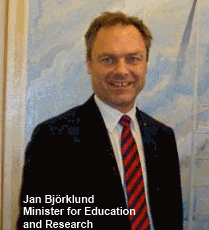|
News & Views item - September 2012 |
![]() Sweden is to Significantly Up Its Commitment to Research and Development.
(September 26, 2012)
Sweden is to Significantly Up Its Commitment to Research and Development.
(September 26, 2012)
According to Wikipedia's List of countries based on research and development spending as a percentage of GDP in real terms (PPP), the latest data available rank Sweden 3rd at 3.3% of GDP while Australia is ranked equal 16th grouped with the UK and Belgium at 1.7%.
 ScienceInsider
now reports that "the Swedish government proposes to raise its spending on
research and innovation significantly. A new plan calls for adding A$589 million
(SEK $4 billion) to the annual budget by 2016, a 13.2% increase for this nation
with a population of 9.5 million. The hike would be implemented in steps,
starting with A$255 million in 2013". The budget proposals will be presented to
the Swedish parliament this Thursday with final approval expected in December.
ScienceInsider
now reports that "the Swedish government proposes to raise its spending on
research and innovation significantly. A new plan calls for adding A$589 million
(SEK $4 billion) to the annual budget by 2016, a 13.2% increase for this nation
with a population of 9.5 million. The hike would be implemented in steps,
starting with A$255 million in 2013". The budget proposals will be presented to
the Swedish parliament this Thursday with final approval expected in December.
The proposed budget allocation will stipulate A$44.3 million per year by 2016 to offer Sweden's best researchers an opportunity "to start long-term risky projects".
A$37 million annually will be used to attract top international researchers to Sweden while universities' budgets are to be increased in steps to reach A$132 million annually by 2016 without provisos.
Per Eriksson, the rector of Lund University is clearly elated: "It is a fantastic investment for the future. We do not know yet how this money will be awarded exactly, but it looks very positive for our universities."
However, Christian Broberger, president of the Young Academy of Sweden was more cautious: "The Elite Program is good in principle, but it arrives too late. What we miss are job positions. Universities cannot guarantee junior investigators continuity," and he believes what is most needed is the development of tenure track positions.
According to Karl Tryggvason, a molecular biologist at the Karolinska Institute, "One must congratulate Sweden for having a visionary government which sees higher education and research as a central priority for the country's future, however, simply introducing new funding programs will not be enough", and went on to tell ScienceInsider's Marta Paterlini that rectors and deans are mainly elected based on their qualifications as administrators, and aren't always qualified to support the very best research.
Finally, significant infrastructure hasn't been forgotten.
A$29 million yearly will go directly to the Science for Life Laboratory over the next four years,
A$92.8 million overall for the European Spallation Source (ESS), a next-generation neutron-science facility through 2016 and
A$14.8 million total for the MAX IV, a new synchrotron through 2016